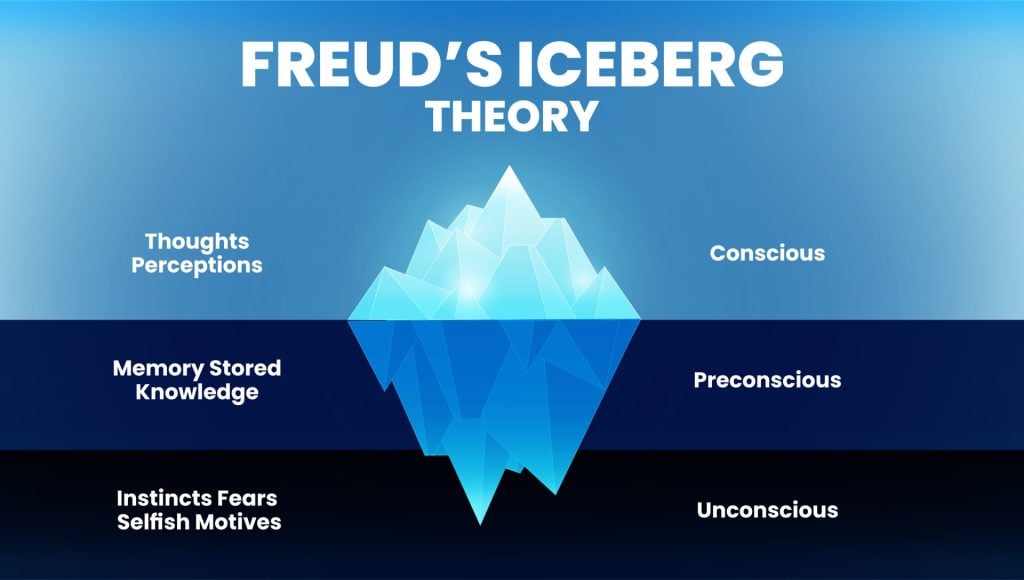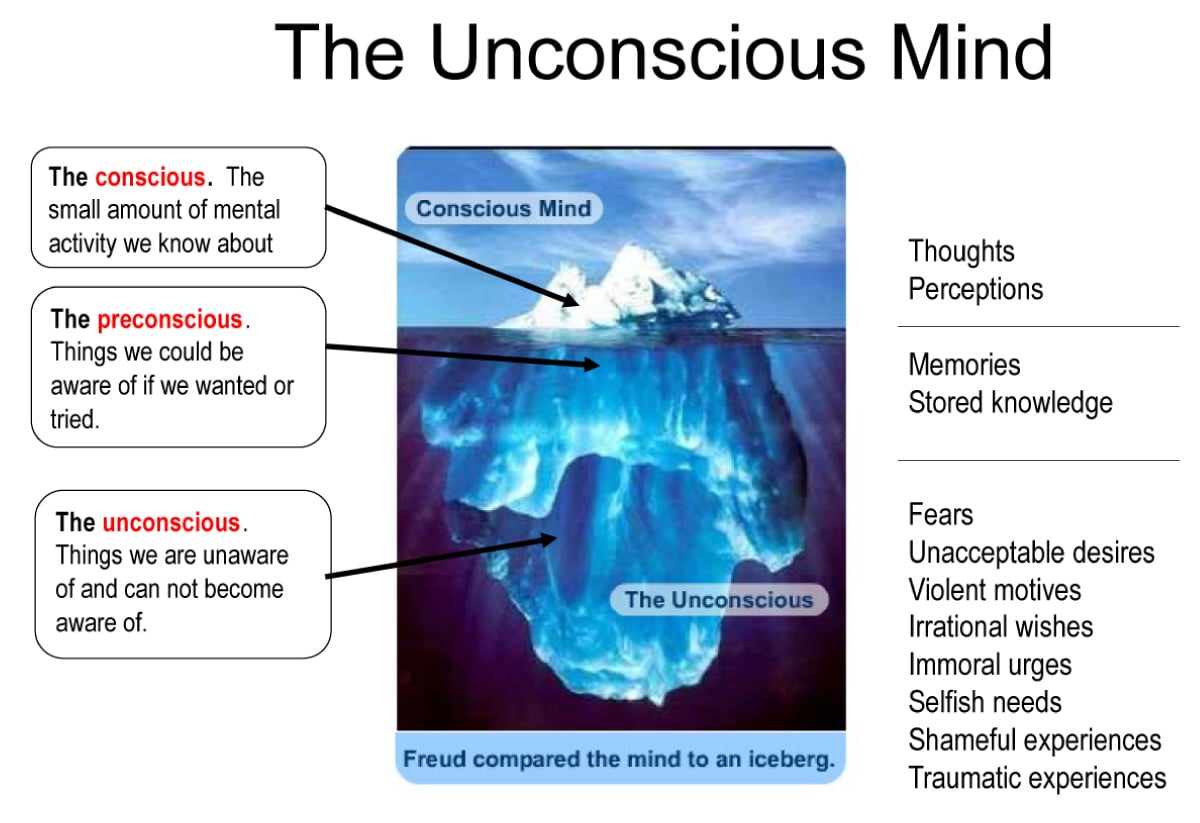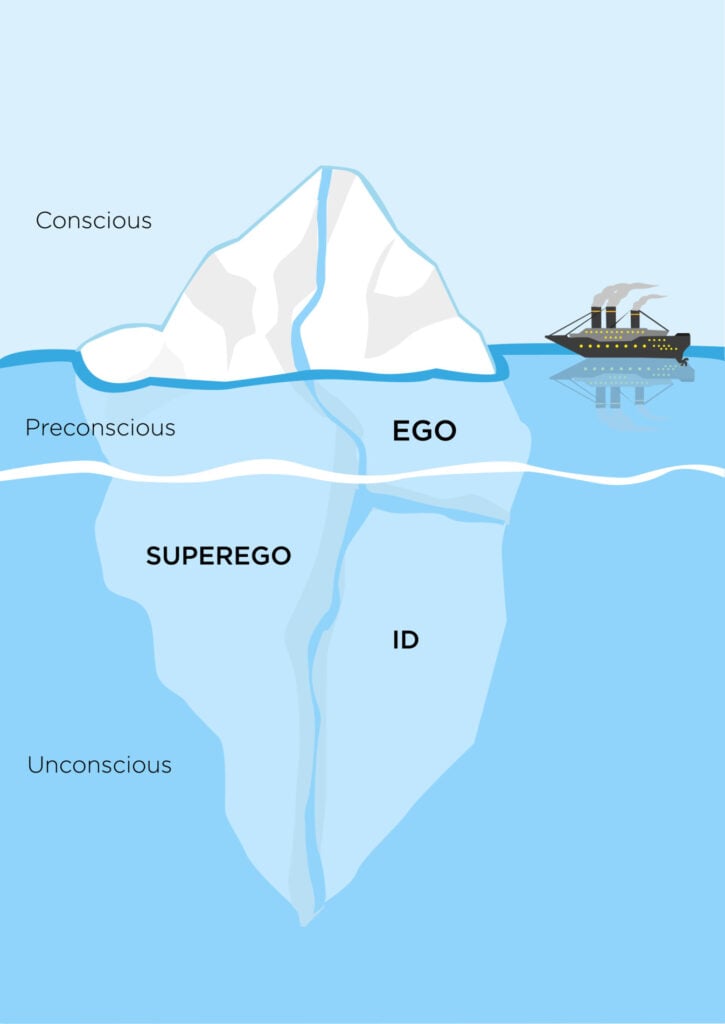On This Page:
Sigmund Freud didn’t exactly invent the idea of the conscious versus unconscious mind, but he certainly was responsible for making it popular, and this was one of his main contributions to psychology.
Freud (1900, 1905) developed a topographical model of the mind, describing the features of the mind’s structure and function. Freud used the analogy of an iceberg to describe the three levels of the mind: conscious, preconscious, and unconscious.
This model divides the mind into three primary regions based on depth and accessibility of information:
Freud’s conception of consciousness can be compared to an iceberg because, much like an iceberg, the majority of an individual’s mind exists below the surface, hidden from immediate view.
Iceberg Theory
Freud’s iceberg theory metaphorically represents the mind’s three levels: the conscious (visible tip of the iceberg), the preconscious (just below the surface), and the unconscious (vast submerged portion).
While we’re aware of the conscious, the preconscious contains easily accessible memories, and the unconscious houses deep-seated desires and memories, influencing behavior despite being largely inaccessible.
Freud (1915) described the conscious mind, which consists of all the mental processes of which we are aware, and this is seen as the tip of the iceberg. For example, you may be feeling thirsty at this moment and decide to get a drink.

The preconscious contains thoughts and feelings that a person is not currently aware of, but which can easily be brought to consciousness (1924). It exists just below the level of consciousness, before the unconscious mind.
The preconscious is like a mental waiting room, in which thoughts remain until they “succeed in attracting the eye of the conscious” (Freud, 1924, p. 306).
This is what we mean in our everyday usage of the word available memory. For example, you are presently not thinking about your mobile telephone number, but now it is mentioned you can recall it with ease.
Mild emotional experiences may be in the preconscious, but sometimes traumatic and powerful negative emotions are repressed, hence not available in the preconscious.
In common language, “subconscious” is often used more generally to describe thoughts or feelings operating below the level of conscious awareness, without the nuanced distinctions of Freudian theory. However, within the context of Freud’s model, “preconscious” (German translation: Unterbewusstsein) has a more specific and distinct meaning.
According to Freud (1915), the unconscious mind is the primary source of human behavior. Like an iceberg, the most important part of the mind is the part you cannot see.
While we are fully aware of what is happening in the conscious mind, we have no idea what information is stored in the unconscious mind.
The unconscious mind acts as a repository, a ‘cauldron’ of primitive wishes and impulses kept at bay and mediated by the preconscious area.
Our feelings, motives, and decisions are powerfully influenced by our past experiences, and stored in the unconscious.
Unconscious Mind
In psychoanalysis, the unconscious mind refers to that part of the psyche that contains repressed ideas and images, as well as primitive desires and impulses that have never been allowed to enter the conscious mind.

Freud viewed the unconscious mind as a vital part of the individual. It is irrational, emotional, and has no concept of reality, so its attempts to leak out must be inhibited.
Content contained in the unconscious mind is generally deemed too anxiety-provoking to be allowed in consciousness. It is maintained at an unconscious level where, according to Freud, it still influences our behavior.
The unconscious mind comprises mental processes inaccessible to consciousness but that influence judgments, feelings, or behavior (Wilson, 2002).
Sigmund Freud emphasized the importance of the unconscious mind, and a primary assumption of Freudian theory is that the unconscious mind governs behavior to a greater degree than people suspect. Indeed, the goal of psychoanalysis is to make the unconscious conscious.
The unconscious contains all sorts of significant and disturbing material which we need to keep out of awareness because they are too threatening to acknowledge fully.
The unconscious mind acts as a repository, a ‘cauldron’ of primitive wishes and impulses kept at bay and mediated by the preconscious area.
Much of our behavior, according to Freud, is a product of factors outside our conscious awareness. People use a range of defense mechanisms (such as repression or denial) to avoid knowing their unconscious motives and feelings.
The unconscious mind acts as a repository, a ‘cauldron’ of primitive wishes and impulses kept at bay and mediated by the preconscious area.
For example, Freud (1915) found that some events and desires were often too frightening or painful for his patients to acknowledge and believed such information was locked away in the unconscious mind. This can happen through the process of repression.
Freud recognized that some physical symptoms may have psychological causes. Hysteria (sometimes known as conversion hysteria) is a physical symptom with no physical cause. However, the ailment is just as real as if it had but is caused by some underlying unconscious problem.
Psychosomatic disorders are a milder version of this. The unconscious is seen as a vital part of the individual; it is irrational, emotional, and has no concept of reality, so its attempts to leak out must be inhibited.
The unconscious mind contains our biologically based instincts (eros and Thanatos) for the primitive urges for sex and aggression (Freud, 1915). Freud argued that our primitive urges often do not reach consciousness because they are unacceptable to our rational, conscious selves.
Freud believed that the influences of the unconscious reveal themselves in various ways, including dreams, and slips of the tongue, now popularly known as Freudian slips.
Freud (1920) gave an example of such a slip when a British Member of Parliament referred to a colleague with whom he was irritated as “the honorable member from Hell” instead of from Hull.
Critical Evaluation
Initially, psychology was skeptical regarding the idea of mental processes operating at an unconscious level. To other psychologists determined to be scientific in their approach (e.g. behaviorists), the concept of the unconscious mind has proved a source of considerable frustration because it defies objective description, and is extremely difficult to test or measure objectively.
However, the gap between psychology and psychoanalysis has narrowed, and the notion of the unconscious is now an important focus of psychology.
For example, cognitive psychology has identified unconscious processes, such as procedural memory (Tulving, 1972), automatic processing (Bargh & Chartrand, 1999; Stroop, 1935), and social psychology has shown the importance of implicit processing (Greenwald & Banaji, 1995). Such empirical findings have demonstrated the role of unconscious processes in human behavior.
However, empirical research in psychology has revealed the limits of the Freudian theory of the unconscious mind, and the modern notion of an “adaptive unconscious” (Wilson, 2004) is not the same as the psychoanalytic one.
Indeed, Freud (1915) underestimated the importance of the unconscious, and in terms of the iceberg analogy, there is a much larger portion of the mind under the water. The mind operates most efficiently by relegating a significant degree of high-level, sophisticated processing to the unconscious.
Whereas Freud (1915) viewed the unconscious as a single entity, psychology now understands the mind to comprise a collection of modules that have evolved over time and operate outside of consciousness.
For example, universal grammar (Chomsky, 1972) is an unconscious language processor that lets us decide whether a sentence is correctly formed. Separate to this module is our ability to recognize faces quickly and efficiently, thus illustrating how unconscious modules operate independently.
Finally, while Freud believed that primitive urges remained unconscious to protect individuals from experiencing anxiety, the modern view of the adaptive unconscious is that most information processing resides outside of consciousness for reasons of efficiency, rather than repression (Wilson, 2004).
References
Bargh, J. A., & Chartrand, T. L. (1999). The unbearable automaticity of being. American psychologist, 54(7), 462.
Chomsky, N. (1972). Language and mind. New York: Harcourt Brace Jovanovich.
Freud, S. (1915). The unconscious. SE, 14: 159-204.
Freud, S. (1924). A general introduction to psychoanalysis, trans. Joan Riviere.
Greenwald, A. G., & Banaji, M. R. (1995). Implicit social cognition: attitudes, self-esteem, and stereotypes. Psychological review, 102(1), 4.
Stroop, J. R. (1935). Studies of interference in serial verbal reactions. Journal of experimental psychology, 18(6), 643.
Tulving, E. (1972). Episodic and semantic memory. In E. Tulving & W. Donaldson (Eds.), Organization of Memory, (pp. 381–403). New York: Academic Press.
Wilson, T. D. (2004). Strangers to ourselves. Harvard University Press.


